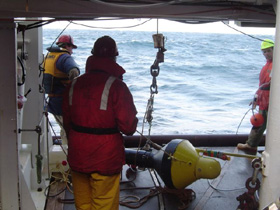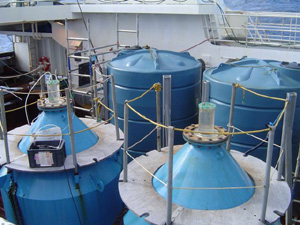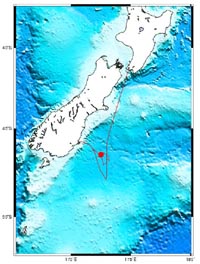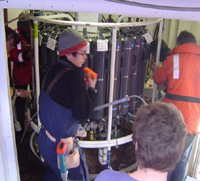Cruise
Log: Thursday, March 25, 2004
|
March
|
|
Sun
|
Mon
|
Tue
|
Wed
|
Thu
|
Fri
|
Sat
|
|
|
1
|
2
|
3
|
4
|
5
|
6
|
|
7
|
8
|
9
|
10
|
11
|
12
|
13
|
|
14
|
15
|
16
|
17
|
18
|
19
|
|
|
|
|
|
|
25
|
|
|
|
|
|
|
|
|
|
|
|
April
|
|
|
|
|
|
|
|
|
|
|
|
|
|
|
|
|
|
|
|
|
|
|
16
|
17
|
|
18
|
19
|
20
|
21
|
22
|
23
|
24
|
|
25
|
26
|
27
|
28
|
29
|
30
|
|
|
 |
| Release
of the Carioca buoy (Photo by Michael Ellwood). |
|
 |
| The
tanks that contained the dissolved iron and tracer gases before
they were released (Photo by Michael Ellwood). |
|
| |
 |
The
location of the RV Tangaroa on March 25, 2004 at 02:00:01.
Position: 46 31. 12S 172 31. 12E |
Tracer and Iron Release
Day
Contributor: Michael Ellwood, NIWA
This is the day we
have all been waiting for - release day. The day dawned fine with only
a moderate swell making it an ideal time to carry out the iron and tracer
gas release. But before the release, two buoys were deployed. One of the
buoys is to mark the center of the patch and the other is a Carioca buoy.
This buoy makes numerous measurements that include seawater fCO2, sea
surface temperature, and salinity. The data and buoy position are then
uplifted to satellite every few hours, thereby providing near "real-time"
feedback on sea surface conditions. Two pre-release CTD casts were conducted
before the infusion of iron to determine biological, chemical and physical
parameters prior to iron and tracer gas infusion. By morning's end, all
the pre-release work had finished and the tracer and iron release began.
The infusion involved pumping the tracer gas and iron solutions over a
twelve-hour period into an area covering ~50km2 called the patch. If all
goes well we should see an increase in the health status of the phytoplankton
community within the patch over the coming week.
 |
| The
scramble for water from the CTD (Photo by Michael Ellwood). |
The Iron Mapping
Team
The iron mapping team
consists of one: Michael Ellwood (NIWA, NZ). The aim of the mapping team
is to determine iron levels inside the patch during the course of the
experiment. In addition, samples will be collected from inside and outside
the patch to determine whether an increase in community health following
iron addition influences the distribution and speciation of other trace
elements.
Acknowledgements
Carioca buoy: Université Paris VI, Laboratoire d'Oceanographie,
LODYC, France.
Next Day >>
|